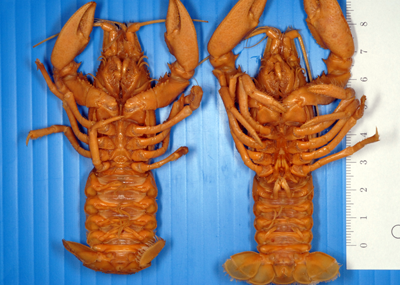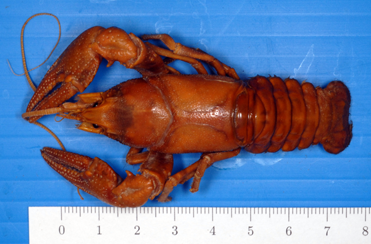St. Lawrence crawfish – Species
Warnings
- Warning for size : Size is indicated for a crayfish that has reached sexual maturity
- Warning for colors: Colors of the photographed specimens can be different from those mentioned in the description, possibly because of the crayfish conservation process
Anatomical diagram of a crayfish

Anatomical diagram of a crayfish (Dubé et Desroches, 2007)

Female (left) – Male (right)

Female carrying eggs
Photos: © Conrad Beauvais, Environment and Climate Change Canada


© Conrad Beauvais, Environment and Climate Change Canada
Appalachian brook crayfish
Latin Name: Cambarus bartonii French Name: Écrevisse de ruisseau
Size
- 18.5 to 36.7 mm.
Fertility
- About 5 to 130 eggs.
Color
- Variable, usually greyish. Can be paler, pinkish or bluish, rarely red or blue.
Morphological characteristics
- Short square rostrum and wide areola • absence of lateral spines on the rostrum • absence of spines behind the cervical groove • irregular punctuation of the areola on three rows • short and massive gonopods (wrench-shaped) • relatively massive claws • single row of low tubercles on the inner edge of the claw.
Habitat
- Very turbulent waters, small or medium streams, can be found in lakes. Rocky bottom.


© Conrad Beauvais, Environment and Climate Change Canada
Allegheny crayfish
Latin Name: Orconectes obscurus French Name: Écrevisse obscure
Size
- 19,9 to 44 mm.
Fertility
- —
Color
- Greenish-gray to brownish. Dark brown spots.
Morphological characteristics
- No ridge on the rostrum • presence of unique cervical spines on each side of the carapace • robust claws • presence of protuberances on the dorsal side of the claws • female gonopores joined in the center.
Habitat
- Lakes, rivers, streams and ponds. Gravelly or rocky substrate.



© Conrad Beauvais, Environment and Climate Change Canada
Big water crayfish or Robust crayfish
Latin Name: Cambarus robustus French Name: Écrevisse géante
Size
- 31.7 to 52.4 mm.
Fecondity
- About 30 to 230 eggs.
Color
- Grayish-brown.
Morphological characteristics
- Elongated and rectangular rostrum • absence of lateral spines on the rostrum • presence of a spine on each side of the carapace behind cervical groove • wide areola • fine and even punctuation of the areola • short and massive gonopods (wrench-shaped) • voluminous claws • two rows of low tubercles on the inner edge of the claw.
Habitat
- Turbulent waters, rocky substrate.


© Conrad Beauvais, Environment and Climate Change Canada
Northern clearwater crayfish
Latin Name: Orconectes propinquus French Name: Écrevisse à rostre caréné
Size
- 16,2 to 38 mm.
Fertility
- About 30 to 130 eggs.
Color
- Brown or dark. Large darker strip on the underside of the abdomen.
Morphological characteristics
- Longitudinal ridge on the rostrum • end of male gonopods’ projections are strait and converging • female gonopore has a central slot.
Habitat
- Wide variety of habitats. Small and medium streams with gravelly or rocky bottom. Clear lake shores.



© Conrad Beauvais, Environment and Climate Change Canada
Calico crayfish or Papershell crayfish
Latin name: Orconectes immunis French Name: Écrevisse marbrée
Size
- 23,2 to 48,8 mm
Fertility
- About 5 to 170 eggs
Color
- Varies from gray to brown. Marbling on the body, especially on the abdomen.
Morphological characteristics
- Slim shape crayfish, frail appearance • wide areola • more than two adjacent dots in its broadest part • reduced or absent lateral tips of the rostrum • presence of a slot near the inner base of the mobile part of the claws (more apparent for large individuals) • male gonopods are much curved • female gonopore has a loop
Habitat
- Pond, banks of slow streams. Presence of aquatic vegetation. Muddy substrate. Shallow (less than 1 m). Can be found in a poorly oxygenated environment.




© Conrad Beauvais, Environment and Climate Change Canada
Northern crayfish or Virile crayfish
Latin Name: Orconectes virilis French Name: Écrevisse à pinces bleues
Size
- 23,2 to 55 mm.
Fertility
- About 360 eggs.
Color
- Grayish to greenish, sometimes reddish brown • Large individuals have blue-greenish colored claws.
Morphological characteristics
- Narrow areola • maximum of two adjacent dots in the thin part of the areola • well developed rostral lateral tips • spine on each side of the carapace, behind cervical groove • male gonopod ends are tapered and slightly curved • female gonopore has a triangular cavity.
Habitat
- Ubiquitous species (encountered in various habitats). Rocky bottom rivers, deep waters of lakes. Also gray-blue clay substrates of agricultural ditches.




© Conrad Beauvais, Environment and Climate Change Canada
Spinycheek crayfish
Latin Name: Orconectes limosus French Name: Écrevisse à épines
Size
- 23,5 to 54 mm.
Fertility
- About 300 eggs.
Color
- Greyish-green. Red marks on the abdomen.
Morphological characteristics
- Two or more spines on the carapace, behind cervical groove • end of male gonopods’ projections short and divergent • presence of two pronounced protuberances in the anterior part of the female gonopore.
Habitat
- Turbid, muddy ground and soft bottom. Wide rivers, streams, medium to large lakes with abundant aquatic vegetation.


© Conrad Beauvais, Environment and Climate Change Canada
Rusty crayfish
Latin Name: Orconectes rusticus French Name: Écrevisse à taches rouges
Size
- Up to 10 cm.
Fertility
- About 80 to 575 eggs.
Color
- Gray-brown carapace and abdomen. Presence of a dorsolateral red spot on each side of the cephalothorax, black stripes near the end of the claws, and small red spots on the abdominal segments. The claws and legs are green.
Morphological characteristics
- Concave rostrum edges • the narrowest part of the rostrum is behind the lateral tips • single lateral spine on each side of the rostrum • robust claws • oval-shaped gap when claws are closed.
Habitat
- Lakes, ponds, and streams. It adapts as well in weak or strong current areas allowing it to go up the river bed and colonize other areas. Rocky substrate, but it can support other substrates such as sand and silt, or the presence of aquatic vegetation.
Note on hybrids
Hybrid specimens are relatively common in crayfish. In Quebec, the most observed cases of hybridization from phenotypic traits is that of the Spinycheek (Orconectes limosus) with the Northern Clearwater Crayfish (Orconectes propinquus). In North America, the most worrying hybridization phenomenon is that of the Rusty Crayfish (Orconectes rusticus) with her cousins of the Orconectes genus, because it is one of this invasive species’ most effective “strategies” the most effective for eliminating its indigenous competitors.
The morphological description of hybrid crayfish is complex. The difficulty arises from the fact that each hybrid will not present the same external characteristics. In the case of hybrids between spiny crayfish and Northern Clearwater Crayfish, a good example would be a specimen that would present the eponymous characteristics of these two species, namely a ridged rostrum and spines behind the cervical groove. However, not all hybrids will show such obvious characteristics, and identification is often more difficult. Genetic tests must be conducted to confirm the presence of suspected cases of hybridization in crayfish of Quebec.
Sources
- Dubé, J., & Desroches, J. F. (2007). Les écrevisses du Québec. Ministère des Ressources naturelles et de la Faune, Direction de l’aménagement de la faune de l’Estrie, de Montréal et de la Montérégie, Longueuil, vol. 51.
- Holdich, D. M. (Ed.). (2002). Biology of freshwater crayfish. Oxford: Blackwell Science, 702 pp
This project is made possible by:
Environment and Climate Change Canada (St. Lawrence Centre, Canadian Wildlife Service, Biosphère) and
Université du Québec à Trois-Rivières (Laboratory of Dr. Gilbert Cabana)



